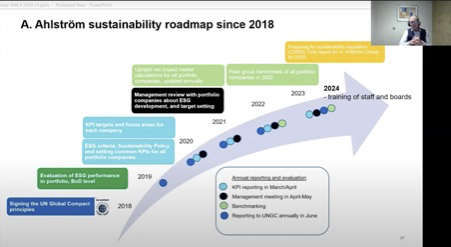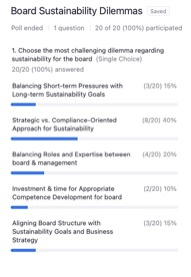On the 9th of January we had the first Peer Exchange from the program “Boards Oversight for Sustainability for Value Creation”, on the topic of Boards Accountability Competence and Processes. The exchange featured prominent speakers, including Andreas, a professor at the Copenhagen Business School, Peter Alstrom, owner and board member of Alstrom Capital company, and Liselotte Engstam the chair of Boards Impact Forum.
We had a diverse audience, with 57% from Nordic countries and 43% from the rest of the world, representing 13 different countries.
Liselotte Engstam started by shedding light on the current dilemmas faced by boards regarding sustainability. She emphasized the challenges of balancing short-term financial pressures with long-term sustainability goals, as well as the potential compliance-driven focus arising from new legislation.

Professor Andreas provided insights into the structural and competency aspects of sustainability for boards. He highlighted the importance of the board mindset, where sustainability could be seen either as risk management or as a driver of long-term value creation. He also emphasized the need for continuous learning and adaptability.

Peter Alstrom, a seasoned business leader, shared his experiences in implementing sustainability strategies within companies. He discussed the role of board committees and how they could effectively oversee sustainability matters.

The presentations were followed by a pool among the participants, identifying the most relevant dilemmas boards face:

Showing that boards struggle to move from the controlling and monitoring towards the strategy integration.
The participants followed to breakout rooms and after discussion shared the following insights, together with the panel of guests:
Governance Models
Different countries may have varying governance models, with some being more transparent and accountable than others. Companies with global operations often struggled to implement consistent governance practices across all locations.
ESG Management Maturity
Evaluating the ESG performance of companies within a group could be challenging. An ESG management maturity framework helped benchmark and assess how well each entity aligned with ESG goals. However, implementing this framework across the board could be complex.
The Role of the Chair
The role of the chairperson in steering ESG initiatives was critical. A proactive chair who championed sustainability could significantly impact how seriously ESG was taken within the boardroom.
Board Involvement in Strategy Development
Boards should actively participat in the strategic planning process, especially when it came to integrating ESG considerations. This involvement ensures that sustainability was not just a compliance issue but a core part of the company’s long-term vision.
Accountability and Ownership
Clear accountability for ESG matters within the board needs to be assigned. This responsibility could be placed on the Chief Sustainability Officer or another board member with the mandate to drive sustainability efforts.
Education and Awareness
Directors underwent training to enhance their understanding of ESG issues and their implications for the company. Better-educated board members could make more informed decisions and contribute meaningfully to ESG-related discussions.
Collaboration and Transparency
Boards encouraged collaboration between management and the sustainability team. Open communication channels ensured that ESG considerations were well-integrated into decision-making processes.
In conclusion, ESG challenges in corporate governance were real and complex, but they were also essential for the long-term sustainability and success of companies. Boards of directors play a pivotal role in addressing these challenges by championing ESG initiatives, fostering accountability, and prioritizing sustainability in their strategic decisions. As the business world continued to evolve, embracing ESG principles would not only mitigate risks but also drive innovation and value creation.








Recent Comments